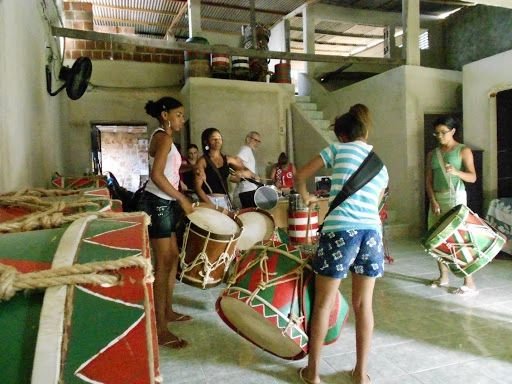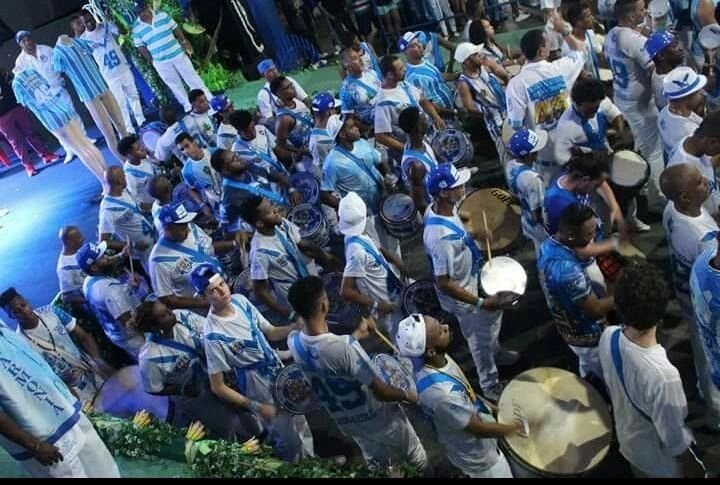BRAZILIAN BLACK MUSIC: LATIN AMERICA BEYOND THE STIGMAS
January 21, 2020
by Juliana Cantarelli Vita and Chico Santana, Ph.D.
Every February, North Americans take time to celebrate and recognize the central role of Black People in U.S. history. With this article, we intend to go a little farther than North America, focusing on South America and more specifically on Afro-Brazilian traditions. Before we dive into two Afro-Brazilian musical traditions that comprise the focus of this paper (namely, maracatu de baque virado and samba), let's briefly discuss the ways in which Brazilian music may be positioned among marketable and social categories. Being Brazilian means to be Latinx, even though some Brazilians often do not recognize themselves as such due to the fact that the term "Latinx" is normally associated with Hispanic cultural traits (which is not a part of Brazilian music/culture necessarily). We argue, however, that is important to recognize Brazilians as Latinx, as the term bonds cultures who have been historically oppressed and colonized.
With that said, yes, we are a part of América Latina (yes, America is a continent and not a country), but Brazilian music has known a wide influence of African cultures, beyond the aesthetics and musical "sound" itself all the way to the meanings and contexts of the musical performances. As Agawu (2003) argues, the concept of "African music" is a problematic one: a whole continent cannot be represented by "one" music. Then, when we think about African traits in Brazilian music, we may observe the diversity of African elements. Of course, this view contrasts with mainstream history courses taught in the Brazilian education system that focus on a Eurocentric perspective of music’s European facets and thus reduces Africa (and its influences on Brazilian music) to an exotic and stigmatized place. It is important to understand which elements of African culture are inherent in Afro-Brazilian and Latinx music in order to avoid a reduction or misunderstanding of the wide and extremely rich cultural universe of African continent.
The myriad traces of African music in Brazil are a consequence of the long period of slavery time in the country, when Brazil was a Portuguese colony. The forceful bringing of enslaved Africans to Brazilian shores began in 1550 and was not abolished until 1888, during which period Brazil received more enslaved Africans than any other country. West and Central African peoples were forced to embark for Brazil at their ports (most from Luanda, present-day Angola). An estimate of four million enslaved people were brought to Brazil, adding to 40% of the total number brought to all the Americas—North, Central, and South.
As we know, Black History month does not limit itself to times of struggles of African descendants in the Americas. Being aware of these is crucial for an understanding of what comes after, but let's not stop there. The two traditions we are approaching here are a matter of pride and celebration for not only Black communities in Brazil but for Brazilian culture as a whole. This paper addresses ways in which we can embrace Afro-Brazilian music in and as culture in a respectful and responsible manner. What to consider teaching Brazilian music abroad? Considering the complexity of the "African" and "Latin" concepts, what and how do we teach Afro-Brazilian Music outside of its original contexts, where most often stigmas exist in relation to Brazil itself?
In terms of our positionality, it is important to highlight that our identities shift depending on where we are. Although we do identify as White in Brazil, we have been perceived as people of color when living abroad, as both of us have lived outside of Brazil for an extensive period of time (Juliana in the United States, Chico in Germany). More often than not, when abroad, we are put in a conglomerate of "Brazilians," in which ethnicity is not likely to be emphasized. For that very reason, we like and need to make clear that although we are seen as part of a minority group when we are abroad, we belong to a position of white privilege back home. And that makes all the difference when we are teaching traditions that are so close to our hearts that are based in marginalized ethnic groups of which we ourselves are not members. This is especially true when others can and often do perceive us as “insiders” when we are not, no matter how close to our hearts these musical traditions may be, and no matter the extensive training and the permissions we have been granted to share these musics. With this piece, we hope to bring forward our experiences with the Afro-Brazilian traditions of maracatu de baque virado and samba, as we have both been deeply involved with these in Brazil and have been participating in the diasporic movement of these traditions.
Two (of the Many) Afro-Brazilian Traditions
First capture of a coronation ceremony (no date)
Maracatu de baque virado, Black music of the northeast.
Maracatu de baque virado (“turned beat” maracatu, also known as maracatu de nação)* is an Afro-Brazilian genre and cultural tradition from the state of Pernambuco. The term, often shortened simply to nação, refers not only to the performance but also to the performing group themselves. The origins of maracatu de nação lie in the reenactment of the ceremonies of the Kings of Congo, who were slaves that occupied leadership roles within the slave community. The authentic maracatus were created by Bantu descendants (from Angola or Congo) within the enslaved community. After slavery was abolished in Brazil in 1888, nações continued to choose symbolic leaders and evoke coronation ceremonies for those leaders.
Although the annual maracatu performances in the carnival parade are not religious, traditional nações are grouped around Candomblé (an Afro-Brazilian religion based on Yoruba principles), and the principles of that religion infuse their activities. Traditional nações, perform parading with a drumming group of around 100 players who also sing in response to the master singer, as well as a group of dancers and characters, including the king and queen. Dancers and characters dress and behave as the Portuguese royal court of the Baroque era, as both a way of mocking the Portuguese court (as Portugal was the country that colonized and enslaved their ancestors) and a way of legitimizing their own nação. The performance also enacts pre-colonial African traditions, like parading with the calunga, the doll representing different orishas (deities).
Beside the nações, maracatu percussion groups that perform musically “in the style of” maracatus de nação, although not considered a legitimate practice by the nações (i.e., with no historical lineage or ties to religion), play an important role in the dispersal of tradition. Often referred to as “balacatu” (“party” maracatu), these are seen not part of a culture with a set of beliefs, but rather percussion ensembles for “fun practice.” These groups are seen as vessels in which Afro-Brazilian cultural traditions are spread within Brazil and throughout the world. One does not have to conform to Candomblé in order to play maracatu, but there is an understanding of respect and acknowledgment of the origins of the tradition.
Musicians with alfaia
The music entails the thundering sounds of the alfaia (a low-pitched rope drum, similar to the European fielddrum), agbê (shakers that resemble the West African axatse gourd instrument), agogô (high-and-low bell, resembling a gankogui, drawn from West African traditions), and gonguê (single bell, thought to be an influence from East Africa). Some groups, such as Nação Porto Rico, have incorporated the use of atabaques (hand drums).
Nação do Maracatu Porto Rico:
Nação do Maracatu Porto Rico during a rehearsal on the community:
Nação do Maracatu Porto Rico on the 2019 carnival parade:
Samba In a Broader Perspective
Samba is a Brazilian musical genre, with several styles within it: samba enredo, pagode, partido alto, samba de breque, samba canção, samba de roda, among others. More than a genre, samba refers to a broader concept that includes three dimensions: to play (instruments and voice), to dance, and to celebrate. Samba can refer to a song, to a party/celebration or to the dance movements/gestures - sometimes to all these things at the same time. During the 19th century, the word samba was used to convey several kinds of Black manifestations including dance, singing and percussion instruments. Then, when we think about teaching samba music, we may consider this wider concept. In this sense, samba has an intrinsic tie to cultures from some parts of African continent, especially from the Bantu people (like Maracatu). Music is part of a broader context, related to dance and celebration. More than a stigma, it is part of the samba features and determines some of its musical aesthetics and meanings.
Musically speaking, samba has some rhythmic aspects that are inherent to different styles. Each kind of samba has its own features, and the most widespread style is the samba from Rio de Janeiro, or samba carioca, created at the end of the 1920s. This is the style that is known worldwide, which is normally associated to the Brazilian Carnival. Because of it, samba brings some stigmatized and reduced concepts when approached in foreign countries, what creates a great responsibility for the music educator who teaches it. Thus, it is important to discuss and expose the contexts where samba is played, danced and celebrated, pointing out how musical aspects are related to it.
Different from maracatu, samba and its styles has a mediatic appeal, which drove it away from its Black origins. However, it is essential to recognize samba as Black music, forged by oppressed people within social-political tensions and negotiations. The very transformations of this manifestation reflects those processes of denial and acceptance within a racist society. In this sense, samba can be seen as a resistance practice. To teach samba in a foreign context (outside Brazil, in another social context) represents an opportunity to approach historical and social aspects that goes beyond musical aspects.
Example of a "roda de samba" (samba "circle"), with composers presenting "samba de quadra" style (compositions made out the Carnival period):
Considerations for Recontextualization
As rich as these traditions are, their recontextualization outside of their places of origin merit further discussion, especially in terms of transmission and understanding of its context. Teaching and learning practices within both maracatu de baque virado and samba are based on cultural and aesthetics features distinct from Western/European ones. These features along with forced colonial processes have led to pushing both traditions to the margins, especially when it comes to school music curricula.
In terms of transmission, it is crucial to embrace the “ways-of-doing” besides the repertoire. Rose-Anynago Omolo-Ongati (2005) advises that it is always better to incorporate the transmission routines used in the culture of origin. There are several things going on here: when Omolo-Ongati argues for a "same transmission method" in the culture of origin, the author points out to the fact that formal institutions, such as schools and universities, have been incorporating multicultural repertoire in their classrooms but curricula generally adopt solely repertoire, leaving out the unique teaching and learning practices that may differ from formal education practices. In terms of context, Omolo-Ongati also points out that the African perception on the learning of music is that music cannot be properly understood and appreciated without the knowledge of its social and cultural context, and that the challenge for those who are incorporating music of Africa (or African-descent, in the case of maracatu de baque virado and samba), is to determine how the owners of the music define it. It is ideal to grant all music the same attention and accuracy as we do other musical traditions (such as Western art music). After all, both maracatu de baque virado and samba are centuries-old traditions.
Understanding the classroom as a culture-sharing group itself, it is necessary to acknowledge and embrace as much of the transmission that happens in the tradition as possible when teaching Afro-Brazilian music in schools. Every aspect of the recontextualization works in a way or another, as music educators take on the challenge of recontextualizing transmission processes. Passing on living traditions as teachers reshape and recontextualize the music in their own settings, children will have an opportunity to be exposed to issues of careful learning of different traditions, respect, and social justice. A few inquiry points to consider when thinking about context and recontextualization:
Consider several questions pertaining to the multiple “facets” of a musical culture: What is the context—where does the music happen? How does the music function for the people from the culture of origin? What is the role and interaction of musicians and audience?
Present sociocultural constructs associated with the selected musical culture.
What is your positionality related to that particular culture? Make that clear.
Points to ponder when incorporating Afro-Brazilian traditions
One central issue of Afro-Brazilian music learning processes is corporeality/embodiment. In order to have a meaningful experience with samba and maracatu, it is important to place musical elements in the body. For example, make use of the voice and/or body percussion to teach rhythmic patterns before playing them on instruments. Also, teach rhythmic patterns before teaching a song is another pedagogical tool used in these contexts. These methodological strategies points to the orality of Afro-Brazilian manifestations and lead to a more contextualized musical and pedagogical approach. Instead of using of sheet music and focusing on a specific technical skill on an instrument, we should plan to embrace a more holistic approach, trying to develop an embodied perception of Afro-Brazilian music within its context and features. Take time to talk about the context, function, and history of each tradition. In that way, students can be able to develop a consciousness about the wide context of Afro-Brazilian music and culture, going beyond the sonic and technical elements to the development of a critical point of view. In summary:
Teach patterns using your voice and body
Teach rhythmic patterns before teaching the song
Avoid the use of conventional music scores/notation
Resist the temptation to focus on instrument technical skills. Playing together is more important than playing "right".
Take time to talk about the context, function, and history.
Closing thoughts
As thoughtful music educators committed to embracing the unique transmission aspects and accents of the world's musical cultures, how might one go about deploying these techniques in a specific classroom? More deeply, though, how can a person occupying a position of privilege (racially/ethnically, within class or gender, etc.) teach music that belongs to minority groups in respectful and impactful ways? These never-ending reflections should always be in the back of our heads as we plan lessons and build our curriculum, as the curriculum structure itself is something that needs to be problematized.
With this piece, we tried to approach some of these questions within our work with Afro-Brazilian traditions. As Brazilian music educators teaching abroad, it is our attempt to break a stigmatized view of the music we teach and love so dearly. Even more so due to our white-representing-selves-in-our-culture-of-origin position, that demands of us a great responsibility especially when working with musical traditions that have been historically oppressed and marginalized.
In summary, we suggested these two guiding principles:
(i) awareness and disruption of colonial practices imbued in music education curricula, through the embracement of music that has served as resistance for black people in Brazil, and
(ii) methodological approaches that are respectful and critically engaged, going beyond the repertoire/musical skills to building a sense of community through embodied and collective musical practices.
Broadening the conversation about the multiple facets of Afro-Brazilian music, especially since that entails issues pertaining to minority groups, is a way to embody and put in action narratives and considerations outside the Western European canon, disrupting paradigms, in order to build a more equitable future in and through music.
Chico Santana, Ph.D. is an Assistant Professor of Popular Music
Percussion at Federal University of Paraíba (Brazil) where he develops researches in the areas of Music Education, Popular Music, Transcultural Music Studies, and Performance, with focus on percussion, decoloniality, collective apprenticeship, rhythmic and corporeality. He has published books and didactic materials within Projeto Guri (where he worked as Pedagogical Coordinator and Artistic Manager), Percussion, Samba, Batucada (founded and directed the group Bateria Alcalina in Campinas), Ethnomusicology and Music Education. He teaches regularly in Brazil, Latin America and Europe is a percussionist of several groups in João Pessoa, São Paulo, Campinas and Berlin, and acts as interpreter, composer and musical director.
Juliana Cantarelli Vita is a Ph.D. Candidate in Music Education with an emphasis in Ethnomusicology at the University of Washington, and a General Music Teacher at Laurelhurst Elementary School in Seattle, WA. Juliana has completed Orff Schulwerk and Kodaly Pedagogy levels and worked at the Smithsonian Folkways World Music Pedagogy Course at West Virginia University (2015-2020), and at the University of Washington (2018-2020). She has been involved with Nação do Maracatu Porto Rico since 2010, when she developed collaborative research about teaching and learning practices within maracatu traditions, and is the founder and leader of Baque Maré, Seattle's Maracatu group. Juliana has publications in music education journals and a chapter on children's communities of practice in the maracatu de baque virado tradition on the upcoming Oxford Handbook of Early Childhood Learning and Development.
Agawu, K. (2003). Representing African music: Postcolonial notes, queries, positions.
New York, NY: Routledge.
Omolo-Ongati, R. (2005). Prospects and challenges of teaching and learning musics of the world’s cultures: An African perspective. In P. S. Campbell (Ed.), Cultural diversity in
music education: Directions and challenges for the 21st century (pp. 59-68). Queensland,
Australia: Australian Academic Press.
*Maracatu de Baque Virado is a tradition from Pernambuco, not to be confused with Maracatu Cearense (or Maracatu de Fortaleza), which is a completely different tradition. Maracatu Cearense is based in Ceará, another state, and is not related to maracatu de baque virado in any way






